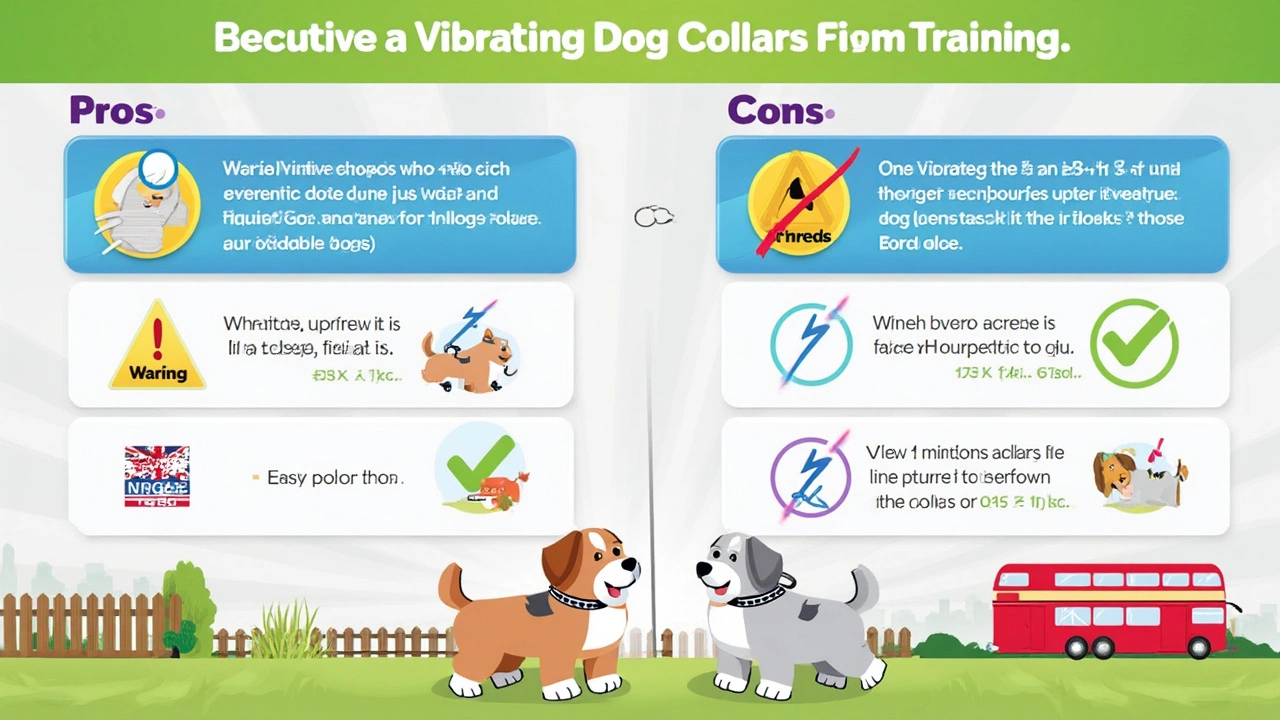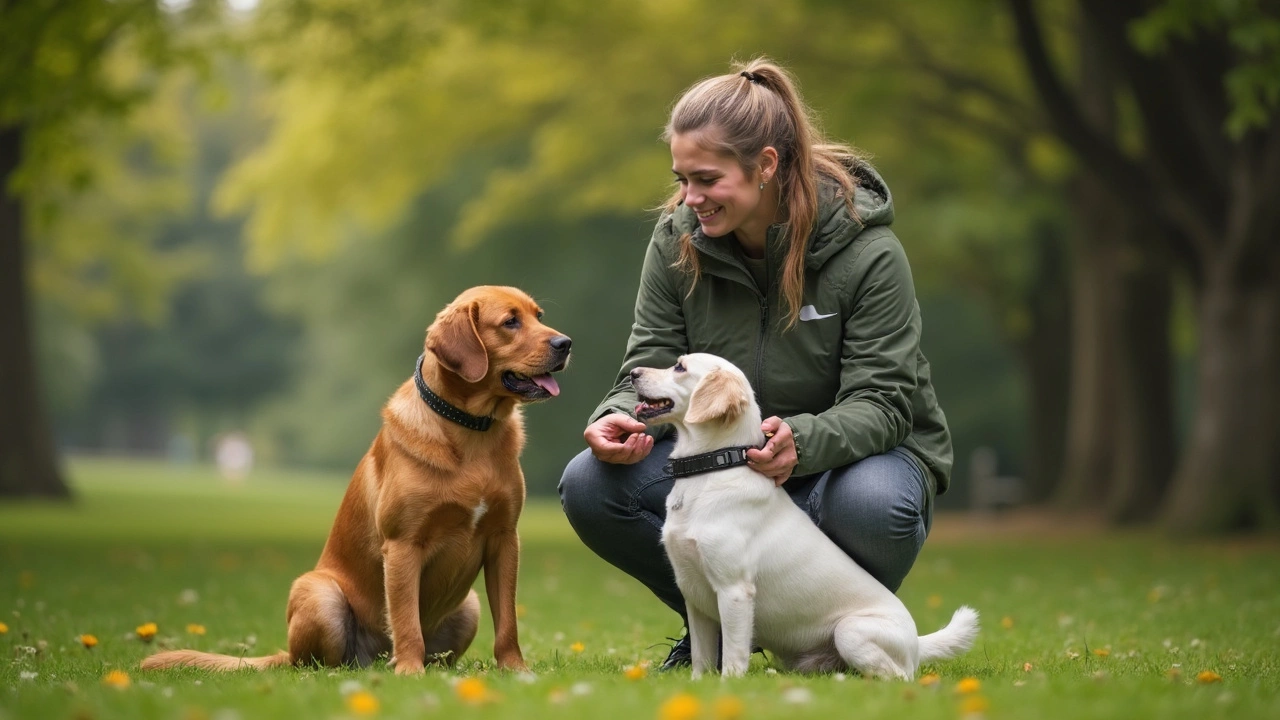Ever seen a chunky remote dangling from a neighbor’s necktie and wondered if their dog might be getting trained by technology instead of treats? Vibrating dog collars have become headline-makers, partly thanks to those viral TikTok videos where dogs halt in their tracks at the lightest buzz. In Bristol’s parks, talk is split—some see these collars as a handy backup for rowdy pups, while others call them harsh or gimmicky. But are vibrating collars actually good for dogs, or are they a shortcut that can do more harm than good?
How Vibrating Dog Collars Work and What Science Says
The idea is simple: when a dog barks excessively or ignores your recall, a small device on their collar sends a vibration—no shock involved. Unlike the old shock collars, vibrating collars don’t fry your pup’s nerves. Most models have settings to adjust intensity, aiming for a quick nudge to grab attention, not punishment. But do they actually work? Here’s where it gets interesting.
Plenty of owners swear by them. In a 2018 UK-based survey, 44% of users said a vibrating collar helped reduce nuisance barking or bad recall. But the real question is what the dog experiences. According to Dr. Susan Hazel at the University of Adelaide, dogs respond best to cues attached to positive reinforcement; she points out that a vibration itself isn’t magical—it’s what happens after that matters. For some dogs, especially those with hearing loss (common in older breeds like Dalmatians or Australian Shepherds), a gentle vibration can signal, “Hey, look at me!” without any fear or pain.
But let’s not sugarcoat it—if used wrong, a vibration collar turns into a random annoyance. Imagine your phone vibrating in your pocket every hour for no reason. That’s what happens if we keep pressing the collar button with no follow-up. Without a reward or clear command, dogs just learn to tune out the sensation or get anxious. The vibrating dog collars market is full of promises, but none of them replace building trust and rewarding the right choices.
Here’s a quick look at the types of vibrating collars out there:
- Remote control collars: The classic. You buzz when your dog does (or doesn’t do) something.
- Automatic anti-bark collars: Trigger a vibration when your dog barks repeatedly.
- Multi-function collars: Combine vibration with tones, beeps, or even gentle sprays.
Statistics matter too. In 2021, the Royal Society for the Prevention of Cruelty to Animals (RSPCA) reported an increase in interest in “humane” dog training aids, but found that less than 1 in 4 trainers would recommend a vibrating collar as a first-line option. Most professionals lean toward positive reinforcement, clicker training, or long leads for recall. It’s telling that in the same period, the UK banned remote-controlled shock collars, but vibrating collars remained legal—implying they’re viewed as less invasive, but still not totally risk-free.
Dogs can't tell us exactly how a vibration feels, but watch body language for signs of stress: pinned ears, tucked tail, or frantic pacing say plenty. In one French study of 40 dogs, 11% showed avoidance behaviors when a vibration collar was triggered randomly—a small but real risk. And when you've got a jumpy rescue dog like Thistle (my cat acts more dog-like than Arlo at times), any unexpected buzz can set off nerves.
Here’s a comparison table of common collar types for training:
| Collar Type | Mechanism | Main Use | Risk Level |
|---|---|---|---|
| Vibrating Collar | Gentle vibration | Attention/recall | Low |
| Static Shock Collar | Electric shock | Bark control, recall | High |
| Citation Collar (Spray) | Scent spray (e.g., citronella) | Bark control | Low/Medium |
| Sound/Ultrasonic Collar | Beeps or ultrasonic tones | Bark control | Low |
Don’t forget—dogs pick up on your vibe, too. If you’re tense about the collar or keep fiddling with the settings, your dog’s going to notice. Trust beats tech every time, but for some pups—like those with hearing impairments—a vibration really can be a compassionate cue. Just don’t reach for a collar before you’ve tried other, friendlier approaches.

The Pros and Cons: What Owners and Vets Need You to Know
Let’s cut through the noise. There’s fanfare about vibrating collars being “cruelty-free”, but don’t fall for slick branding without a peek at the real ups and downs. Some dogs take to these collars like ducks to water—Arlo, my old spaniel, was a total champion learning “come” with a gentle buzz paired with a meaty treat. But Thistle the cat? She’d probably never forgive if I even tried.
On the plus side, vibrating collars avoid the ugly side effects linked to shock collars—pain, panic, or associating the owner with unpleasant feelings. For dogs with hearing loss, studies out of Texas A&M’s vet college have shown improved responsiveness to vibrations compared to shouts or flashy hand signals. Elderly dogs, or those who freeze at loud whistles, might finally understand it’s time to turn around at the park gate. Plus, there’s something wonderfully discreet about being able to cue your dog without yelling to the neighbors.
But distract a dog too often, with no rhyme or reason, and anxiety creeps in. Some dogs get jittery, looking for the source of the buzz. Behaviourists from the RSPCA warn that using a vibe as a punishment (“Stop that—or else!”) can erode trust. For rescues or under-socialised dogs, the stakes are higher—any aversive tool can set progress back, not forward. Vibration, by itself, fixes nothing unless you follow through every. single. time. with praise or reward.
Tips from trainers and researchers help dodge these pitfalls. First, always test the collar on your own wrist—see how it feels. Next, never attach a vibration to bad behavior alone; instead, pair the buzz with a cue (“look at me!”) and reward your dog each time they respond calmly. Never slap a vibrating collar on and expect results. Getting a dog used to the collar as just another accessory—no battery at first!—reduces suspicion. Once training starts, short sessions and consistency matter way more than intensity.
Mistakes happen, though. Some brands set vibrations off too easily, like when a dog shakes or rolls; others use batteries that die at the worst moment. Vets have noted rare but real cases of skin irritation from poorly fitted collars, so fit it snug but never tight. Look for adjustable, padded models with sturdy D-rings for the leash, and beware bargain-bin versions popping up online with dodgy signals or unreliable remotes.
Here's a handy list for picking and using a vibrating collar wisely:
- Start with positive reinforcement—never use the vibration as a sole punishment.
- Let your dog wear the collar without using the vibration for a few days.
- Use the vibration only as a cue; immediately reward correct responses.
- Monitor for signs of stress (pacing, drooling, looking for escape).
- Consult with a certified dog trainer if unsure—especially with nervous or previously abused dogs.
- Test the collar yourself first—never trust marketing claims alone.
- Clean the collar and check for skin irritation weekly.
Cost can be a clue, too. Most reputable vibrating collars cost between £40 and £120 in the UK, with top brands including DogCare, PetSafe, and Dogtra. Some even have smartphone integration, letting you track training or lost-dog location—but again, the dog doesn’t care about fancy tech, only clear communication and comfort.
Can vibrating collars really be “good for dogs”? The real world says: yes, under tight conditions. They work for specific kinds of training (recall, hearing-impaired dogs, controlled settings), but flop as quick fixes for serious behavioral problems. Vets and pros agree, they should only ever back up rock-solid, reward-based training—never act as a lonely shortcut when the real answer is more patience or creativity.

Alternatives, Best Practices, and Real-Life Stories from Bristol Parks
A walk on The Downs or a muddy spin by the Avon quickly turns into a survey about dog training tools if you’ve got treats in your pocket. Vibrating collars pop up, mostly as last-ditch efforts for stubborn recall or the “silent dog whistle” for off-leash wanderers. But most Bristol owners say they only buy them after running through the usual toolkit—voice commands, high-value treats, long leads, and squeaky balls stolen by passing magpies.
Alternatives deserve a quick reality check. Clicker training (think: the sound of a ballpoint pen) remains the gold standard. Dogs associate a neutral click with a tasty treat, rewiring their brains to “work” for rewards. Long leads—basically super-sized leashes—offer control while letting a pup sniff and roam safely. For city slickers who dread barking, noise-cancelling machines or puzzle feeders help channel energy elsewhere. And, of course, old-school patience—sometimes it’s the only thing that works, especially with clever hounds or skittish rescues.
Here's a “best practice” routine that’s worked for dogs from Clifton to Bedminster:
- Introduce the vibration collar with it turned off, as just another collar in the rotation.
- Pair the vibration with your chosen cue (“look!”) while at home in a low-distraction setting.
- Let the dog smell and inspect the remote—curiosity kills suspicion.
- Keep sessions under five minutes, and end with a game or cuddle, not just food.
- Gradually move training into new environments, but never use the collar as punishment.
- Watch for signals: happy tail, relaxed mouth, focused eyes mean you’re on track.
My old Arlo responded to vibration paired with a roast chicken chunk far better than my clumsy voice ever did on windy afternoons. Thistle, the cat, looked on in total confusion but never seemed bothered—mostly because she was plotting how to steal the treats herself.
By now, you’ve probably guessed vibrating collars aren’t magic buttons or evil gadgets. They’re best reserved for owners who are willing to put in the groundwork. If you’re staring at the online reviews and can’t decide, ask yourself: Have I tried positive reinforcement, clickers, or long leads? Is my dog anxious or confident? Am I willing to commit to daily, reward-heavy training? If the answer is ‘no,’ maybe it’s not the right time for a vibrating collar, and that’s okay.
Bottom line: use any tool—no matter how clever—only as part of a toolkit based on trust and consistency. If you’re feeling stuck, reach out to a local trainer, join a Bristol dog group, or just swap stories at the park. Sometimes, the best advice comes from the next muddy-pawed neighbor whose dog’s recall finally clicked—not because of a clever gadget, but because training, treats, and trust are what really stick.








